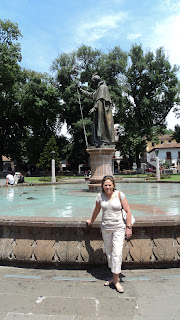Santa Fe is a billion dollar commercial real estate development on the western side of Mexico City built over a zone that 30 years ago were mostly garbage dumbs, beside a quiet village named Santa Fe, that was founded in the XVIth century, by a dreamer and social reformer, Vasco de Quiroga.
High rise apartments in
Santa Fe business Park,
Mexico City
New high-rise office space in
the Santa Fe Business Park
Hernan Cortes conquered the Great Tenochtitlan, present day Mexico City, in 1520. As this was the center of the Aztec Empire, most of what we know as Mexico today, rapidly came under control of the Spanish over the following months and years, as most of the Aztec Empire had been controlled by their allies, and in certain cases, by their rivals, that naturally became allies of the Spanish, as was the case of the tribes from Tlaxcala. However the years after the conquest found the former Aztec people in a state of utter desperation. Just as Hernan Cortes and his 400 Spanish soldiers had been extremely competent in war, the reconstruction of the conquered kingdom under the new Spanish rulers was in a state of total chaos. One thing is to conquer an empire, another quite different to prevent it from collapsing once conquered.
Santa Fe Church, outskirts of Mexico City
King Carlos V of Spain sent a board of governors shortly after the conquest, called the Audiencia. This first Audiencia not only proved to be very incompetent, but corrupt as well. Both Hernan Cortes and Carlos V realized that the situation was explosive, so the king confided for new board of governors of Mexico to his life-long trusted lawyer and confidant, Vasco de Quiroga. When Vasco de Quiroga arrived to Mexico, in 1531, he formed an alliance with Zumarraga, the Franciscan Friar and first Archbishop of Mexico City, and both of them worked together on the Second Audiencia or Board of Governors. What they found out about the First Audiencia was so scandalous that Zumarraga and Vasco de Quiroga advised that the members of the First Board of Governors to be incarcerated, and the its chief executive was sent back to Spain in chains to face charges and imprisonment.
A closer look at the atrium and the entrance of
Santa Fe, Tacubaya, Mexico City
Shortly after he arrived to Mexico City, Vasco de Quiroga would take early morning strolls through the streets and what he discovered was shocking: heaps of corpses of recently born babies, that had been strangled by their mothers. When Vasco de Quiroga asked passer-byes why mothers were doing something so horrific to their children, the answer was always the same: "Death is better for our children, than life in this city without hope, without future, and with so many of our people dying anyway from diseases brought here by the conquerors."
When Vasco de Quiroga mentioned this incident to Zumarraga, the archbishop asked Vasco if he had read a book that Thomas More had just written: Utopia. "We Europeans, we Spanish, have a unique opportunity in history, in this moment, in these circumstances, with this people to correct everything we have done wrong in Europe for centuries, and start a new society from scratch, a Utopia." (The quotation marks are mine, as this is a loose translation our their discourse, but faithful to the main ideas they discussed.)
Patzcuaro has a very particular building style,
tile roofs, whitewash walls, wide areas for
parks, public gardens, and markets.
Vasco de Quiroga was a wealthy man, already in his late 50's or early 60's. He proposed to develop a test-settlement some 7 miles from the center of Mexico City, which he named Santa Fe. It included a Church, a dispensary, a small clinic, a childcare center and a small town hall, so that the naturales of native Aztecs could come together and discuss issues of self-government. He needed and requested funds for this project from the Spanish Crown, but he would constantly take money out of his own pockets to finance his Santa Fe project.
Statue of Vasco de Quiroga
1470-1565
in the center of a fountain
Patzcuaro, Michoacán
The Basilica de Nuestra Señora de La Salud or
The Cathedral of Patzcuaro,
designed by Vasco de Quiroga
Cathedral of Patzcuaro
Main Nave
Bell tower
Cathedral of Patzcuaro
Stone carved Baptismal
Fountain
The Tarascan Indian artisans
carved this pulpit for a Colonial
Church out of a single piece of
granite.
Flour mill grinding stone
Courtyard in Patscuaro, Michoacán
The Santa Fe was an instant success. Zumarraga challenged Vasco de Quiroga, "What are you doing losing your time? Become a priest and give these people your fulltime attention!" Several months later, Zumarraga ordained Vasco de Quiroga as a priest.
The situation of Mexico City gradually started to improve, but towards the west, in the former realm of the Tarascan Indian Tribe Kings, the situation was becoming a powder keg, So Cortes and Zumarraga advised Carlos V to send Vasco de Quiroga into the area of present day Michoacán to continue his social experiments and missionary efforts. Several of the "huataperas" (purépecha native language word) or meeting places he established are still in use by the natives peoples.
Vasco de Quiroga established a string of missions from Santa Fe, on the western edge of Mexico City, all across the state of Michoacán, including the villages around the lakes and the town of Patzcuaro. His zeal for building churches was such that his project for the Cathedral of Patzcuaro was bigger than Zumarraga's project of the Cathedral of the City of Mexico.
Vasco de Quiroga continued his missionary work, walking from one mission to the next, until he was 93 years old. After one day in which he walked several miles, he arrived very tired to one of his missions. That evening Vasco de Quiroga passed away.


















No comments:
Post a Comment